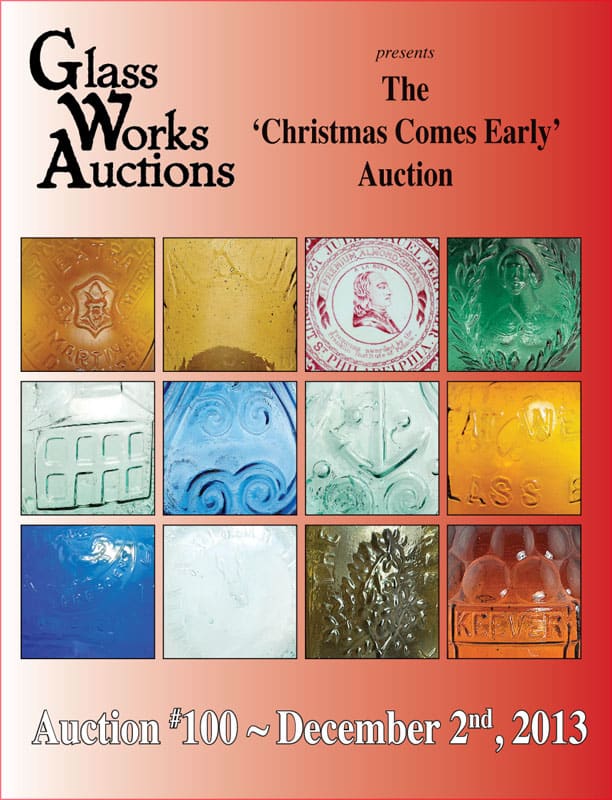Thanks for the emails in support of the website change with regards to the addition of glop tops. Let's start off with one of my favorites; The red whittled glop tops~
_________________________________________
"The German Connection"
Several years ago, Tom Quinn coined this phrase and
wrote an in depth article that was included in John Thomas's posthumous work
entitled "Whiskey Bottles of the Old West". The name stuck and the
blood red and heavily whittled glop top western whiskies are now commonly
referred to as "German Connection" glops.
A brief background on the
"German Connection";
Prior to the 1890's, all San Francisco & Pacific
Glass Works (SF&PGW) glassblowers had been paid by the piece (individual
bottles blown). In an attempt to keep pace with the ever growing demand for
bottles, SF&PGW "imported" seasoned glass blowers from the Pennsylvania
People and Companies
A large percentage of the liquor dealers in pre 1900
S.F. were of German descent. Names like Taussig, Braunschweiger, Kolb,
Fenkhausen, VanBergen, Hildebrandt, Rothenberg, etc, etc, filled the S.F.
liquor directory. A company by the name of Abramson Heunisch also appeared in
the directory. But they weren't liquor dealers. Instead they supplied corks,
labels and other items required to merchandise liquor. They were located at 26
& 28 Main St.
They also had an office (not so coincidentally) at Chauses Strasse 113 inBerlin
Germany Germany and claimed to be the largest producer
of glass bottles in Germany Opportunity knocked and soon Abramson Heunisch was appointed the US Pacific
Coast sole agency for Gerresheimer Glasshuttenwerk. New molds for San Francisco liquor wholesalers were immediately cut and
shipped to Gerresheimer Glasshuttenwerk and the flow of German bottles soon
filled the vacuum left by the loss of skilled labor in San Francisco
At first glance, these bottles closely resembled those still being produced by San Francisco & Pacific Glass Works. But put side by side, the difference is immediately evident.
They also had an office (not so coincidentally) at Chauses Strasse 113 in
At first glance, these bottles closely resembled those still being produced by San Francisco & Pacific Glass Works. But put side by side, the difference is immediately evident.
The early 1890's era saw the introduction of the hand
pump, and advanced air venting techniques which replaced mouth blown bottles
and eliminated much of the crudity seen previously. It also saw the gradual
phase in of semi automated finishing techniques which resulted in the older
applied top whiskey being phased out in favor of the tooled top. This resulted
in more uniform bottles that could be produced faster, and therefore more
economically. And so, domestically produced bottles were neater and had tooled
tops, as opposed to the German bottles which were crudely made and had applied tops.
Domestic vs. German - The
Difference
The German glass factories produced both clear and
amber whiskies for the San Francisco
The "amber" German bottles were formulated
with a type of sand that produced a color generally called ox or pigeon blood
red. Some are extremely dense in color, others have barber pole swirls of different colors, and yet others are a bright light shade of red / orange. Here's a few examples.
A significant difference from the somewhat mundane brown hues seen in the
domestic counterparts. On rare occasions,
the glass blower would dip from the wrong tank and a "straw" colored
variant would slip through the cracks. These were normally tossed back in the
cullet to be re-melted, and the correct colored bottle would be blown from the
proper glass batch. A straw colored German "western" whiskey is one
in a million!
The next time that you pick up a J. A. Gilka, or a
Warners "Frankfurt " Safe Cure,
compare these bottles next to a blood red, hammer whittled, glop top
"western" whiskey. "The German Connection" will be obvious~
Just a quick PS;
Apologies for the pictures. It's dark and gloomy here; these are tough to get good photos of in this type of lighting, all but void of sunlight.
Also:
I received a question about the new comment posting procedure.
Just a quick PS;
Apologies for the pictures. It's dark and gloomy here; these are tough to get good photos of in this type of lighting, all but void of sunlight.
Also:
I received a question about the new comment posting procedure.
I got a warning that someone or something had tried to
hijack the site. I had to create a new comment tool. It allows anyone to write a comment, which is
then forwarded to me for manual submission. It's just one more pain
in the butt for me, but it will keep the site clean and spam / virus / malware
free.























































